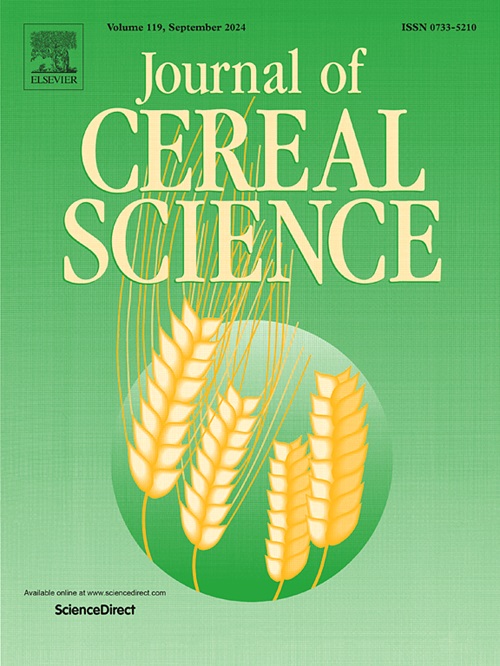冻融循环中三散对热变性小麦面筋组成、结构和性能的影响
IF 3.9
2区 农林科学
Q2 FOOD SCIENCE & TECHNOLOGY
引用次数: 0
摘要
三散与热变性小麦面筋蛋白(hddg)的相互作用对熟面品质有显著影响。本研究构建了三散-HDWG模型系统,考察了不同浓度三散(0%、0.3%、0.6%、0.9%、1.2%、1.5% w/w)对冻融循环中HDWG组成、结构和性能的影响。结果表明:添加0.9%的三散,FT循环后HDWG的硬度降低了3.53%,弹性提高了5.37%;这是由于形成了更密集、更连续的HDWG网络结构。然而,过量的三聚氰胺(1.5%)在FT循环中由于位阻和氢键断裂而无法减轻HDWG网络的损伤。构象分析表明,添加0.9%三散降低了间扭式-间扭式-间扭式(g-g-g)的减少比例(20.81%)和酪氨酸残基的暴露,从而稳定了HDWG的结构变化。分子间相互作用力表明,三散通过减少HDWG内部氢键断裂和二硫键断裂,促进HDWG分子间交联,从而提高HDWG的流变性能和冻融稳定性。本研究揭示了三散与HDWG的相互作用机制,为三散在pcn中的应用提供了理论支持。本文章由计算机程序翻译,如有差异,请以英文原文为准。

Effect of sanxan on the composition, structure and properties of heat-denatured wheat gluten during freeze-thaw cycles
The interaction between sanxan and heat-denatured wheat gluten protein (HDWG) significantly impacts the quality of prepared cooked noodles (PCNs). This study constructed a sanxan-HDWG modeling system to examine the effects of different concentrations of sanxan (0%, 0.3%, 0.6%, 0.9%, 1.2%, 1.5% w/w) on the composition, structure, and properties of HDWG during freeze-thaw (FT) cycles. The results showed that adding 0.9% sanxan reduced the hardness of HDWG by 3.53% and increased its springiness by 5.37% after FT cycles. This is attributed to the formation of a denser and more continuous HDWG network structure. However, excessive sanxan (1.5%) fails to mitigate HDWG network damage during FT cycles due to steric hindrance and hydrogen bond breakage. Conformational analysis indicated that adding 0.9% sanxan reduced the proportion of gauche-gauche-gauche (g-g-g) decrease (20.81%) and the exposure of tyrosine residues, thereby stabilizing the structural changes of HDWG. The intermolecular interaction forces indicate that sanxan promotes intermolecular cross-linking of HDWG by reducing hydrogen bond breakage and disulfide bond cleavage within HDWG, thereby enhancing the rheological properties and freeze-thaw stability of HDWG. This study revealed the interaction mechanism between sanxan and HDWG, providing theoretical support for the application of sanxan in PCNs.
求助全文
通过发布文献求助,成功后即可免费获取论文全文。
去求助
来源期刊

Journal of Cereal Science
工程技术-食品科技
CiteScore
7.80
自引率
2.60%
发文量
163
审稿时长
38 days
期刊介绍:
The Journal of Cereal Science was established in 1983 to provide an International forum for the publication of original research papers of high standing covering all aspects of cereal science related to the functional and nutritional quality of cereal grains (true cereals - members of the Poaceae family and starchy pseudocereals - members of the Amaranthaceae, Chenopodiaceae and Polygonaceae families) and their products, in relation to the cereals used. The journal also publishes concise and critical review articles appraising the status and future directions of specific areas of cereal science and short communications that present news of important advances in research. The journal aims at topicality and at providing comprehensive coverage of progress in the field.
 求助内容:
求助内容: 应助结果提醒方式:
应助结果提醒方式:


